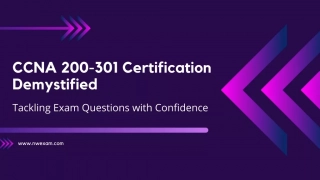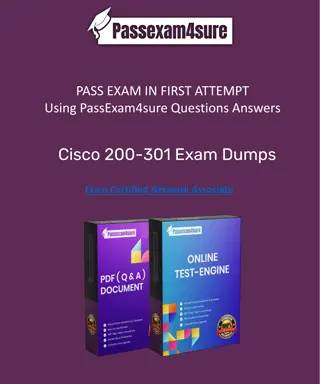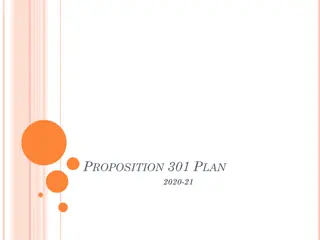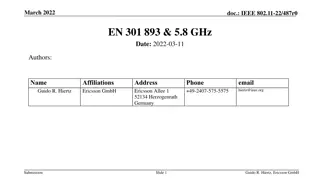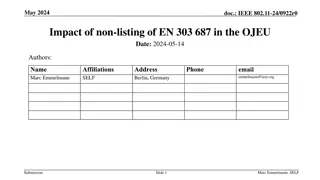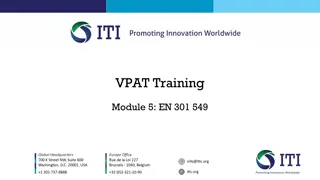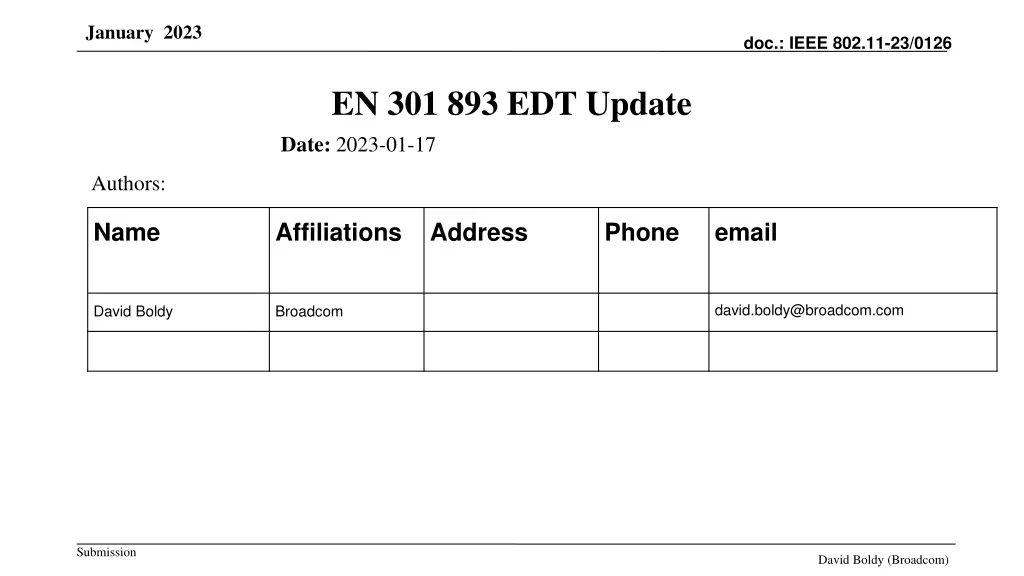
IEEE 802.11-23/0126 Update on EDT in EN 301.893 Standard
Stay informed about the latest updates regarding the Energy Detection Threshold (EDT) in the EN 301.893 standard based on the submissions by David Boldy from Broadcom. The document includes key details from the ETSI BRAN Meeting#117, addressing issues related to Maximum PSD levels, proposal considerations, and concerns raised by Broadcom. Proposed solutions are also outlined to mitigate potential challenges. Keep up to date with the evolving standards in the field of wireless communications.
Download Presentation

Please find below an Image/Link to download the presentation.
The content on the website is provided AS IS for your information and personal use only. It may not be sold, licensed, or shared on other websites without obtaining consent from the author. If you encounter any issues during the download, it is possible that the publisher has removed the file from their server.
You are allowed to download the files provided on this website for personal or commercial use, subject to the condition that they are used lawfully. All files are the property of their respective owners.
The content on the website is provided AS IS for your information and personal use only. It may not be sold, licensed, or shared on other websites without obtaining consent from the author.
E N D
Presentation Transcript
January 2023 doc.: IEEE 802.11-23/0126 EN 301 893 EDT Update Date: 2023-01-17 Authors: Name Affiliations Address Phone email david.boldy@broadcom.com David Boldy Broadcom Submission David Boldy (Broadcom)
January 2023 doc.: IEEE 802.11-23/0126 Abstract Updates from ETSI BRAN Meeting#117 (related to EDT in the EN 301 893 standard). Submission David Boldy (Broadcom)
January 2023 doc.: IEEE 802.11-23/0126 Background At BRAN#117 EN 301 893 stable draft v2.1.50 was sent for EC assessment. This version included the accepted text for a new PSD scaled proposal for EDT from BRAN(22)116e003r3. TC BRAN agreed that further work needs to be done prior to submission to ENAP to address the Maximum PSD levels for transmissions within a larger configured BW issues highlighted in the Broadcom contribution BRAN(22)117009 response document and captured for further work in clause 4.2.7.3.2.5 by the square bracketed text: [For concurrent operation on more than 4 channels, 3 dB shall be added to PSDmax.]. Submission David Boldy (Broadcom)
January 2023 doc.: IEEE 802.11-23/0126 PSD scaled proposal from BRAN(22)116e003r3 The following was included in draft v2.1.50 sent of EC assessment: 4.2.7.3.2.5 Energy Detection Threshold (EDT) (LBE) The EDT shall be 85 dBm/MHz + (PSDlimit PSDmax) with a minimum of 85 dBm/MHz and a maximum of 75 dBm/MHz, where PSDmaxis the maximum PSD when using all channels in the configured combination/grouping of channels and PSDlimitis the PSD limit in the sub-band of operation. [For simultaneous operation in more than 4 channels, 3 dB shall be added to PSDmax.] The [square bracketed text] needs addressing by ETSI BRAN prior to sending into Public Enquiry/ENAP (EN Approval Process) Submission David Boldy (Broadcom)
January 2023 doc.: IEEE 802.11-23/0126 Broadcom concern raised in contribution BRAN(22)117009 The proposed language in BRAN(22)116e003 allows partial use of a full configured bandwidth without limiting the PSD to this configured BW. This allows devices to use a higher EDT to gain access to the channel but then have actual transmissions at lower bandwidths with much higher PSDs. For example: the proposal allows a 160MHz AP (or LAA/NRU) to sense the channel at ED at -63dBm at 23dBm max transmit power considering the lower PSD over 160MHz, but then transmit on 20MHz with an 8 times higher PSD. Submission David Boldy (Broadcom)
January 2023 doc.: IEEE 802.11-23/0126 Proposed solution If the actual transmission bandwidth of the device is lower than the configured BW it should either: be limited to the same PSDmaxas that of the higher configured BW ( i.e. similar to WiFi spatial reuse based on OBSS PD) or the EDT level should be reduced in accordance with the equation 85 + (PSDlimit PSDmax) dBm/MHz where PSDmaxis the PSD for the actual transmission BW. The following additional text for clause 4.2.7.3.2.5 was proposed to address the above: For multi-channel operation, where transmissions can occur only in a part (i.e. "n" used channels in a group of adjacent channels) of the total bandwidth (N), the maximum EDT that applies prior to transmission shall be based upon the maximum PSD (PSDmax) that applies for the total bandwidth (N). At this maximum EDT, the PSD of such (n x 20 MHz) partial bandwidth transmissions shall not be greater than the PSDmaxcorresponding to the total bandwidth (N). Lower EDT may be used to increase the PSD on partial data transmissions according to the equation above. Submission David Boldy (Broadcom)
January 2023 doc.: IEEE 802.11-23/0126 Theoretical vs pragmatic (1) Although it was not contested that from a theoretical perspective the approach on slide 6 addresses the concern highlighted some were looking for a more pragmatic approach. Offline discussions to try and find a pragmatic compromise to the PSD scaled proposal led to the addition of the square bracketed text in the draft standard: [For simultaneous operation in more than 4 channels, 3 dB shall be added to PSDmax.] NOTE: Broadcom made it clear during the BRAN#117 meeting that they did not agree with the proposed text in square brackets but agreed to including this bracketed text on the understanding that TC BRAN continue to work on new text to address Broadcom concerns prior to finalization of the standard. Submission David Boldy (Broadcom)
January 2023 doc.: IEEE 802.11-23/0126 Theoretical vs pragmatic (2) The bracketed text does not fully address the problem highlighted and further language is required to close out potential misuse of the specification and unfair sharing of the spectrum. After further investigation since BRAN#117 it is not seen that there would be significant burden to regulatory testing when comparing a slide 6 based approach and other pragmatic approaches proposed. Any non-mandatory testing would not be significant and would be proportional to the complexity of the driver (e.g. Dynamic EDT) and any channel access benefits that a manufacturer is trying to achieve fairly. Submission David Boldy (Broadcom)
January 2023 doc.: IEEE 802.11-23/0126 Next steps Highlighted issue needs to be resolved prior to sending into ENAP. Next scheduled meeting BRAN#118 (27thFeb 3rdMarch) Note: Broadcom are working on an updated proposal with a simplified test to socialize prior to BRAN#118 but open to other new pragmatic solutions that prevent misuse and enable fair sharing. Submission David Boldy (Broadcom)
January 2023 doc.: IEEE 802.11-23/0126 Related information Extract from BRAN#118 meeting minutes - BRAN(22)117002 The following guidance is agreed in BRAN(22)116e003r3 and is listed below: With respect to IEEE 802.11ax equipment only, ETSI TC BRAN agrees that such equipment could be treated under the existing rules for option 1 EDT defined in EN 301 893 v2.1.1 clause 4.2.7.3.2.5 until the date of withdrawal of that standard. ETSI TC BRAN will contact the EC before ENAP to discuss the acceptance of an extension to the default date of withdrawal to at least 36 months after listing of the new version of the standard in the Official Journal. Typical transition period to of standard to new EDT requirements (at least 18 months after citation in OJEU) ~mid 2025. Above increases transition to early 2027. Submission David Boldy (Broadcom)

